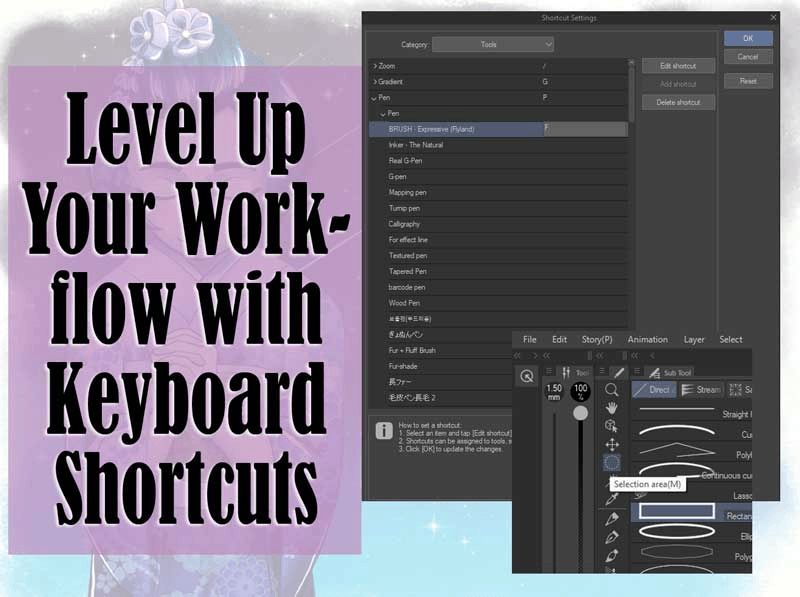TIPS FOR DRAW FACES IN ALL ANGLES
When we need to draw a head/face we are always faced with a certain difficulty at first. What I bring here are some tips based on the vast material available in books, CSP resources and a little bit of my professional experience. The oval and central axis method.
We'll start with a video but soon after that we'll have a breakdown with texts and images.
VIDEO - Tips for draw faces in different angles
In this video - How to draw faces and heads in different angles in Clip Studio Paint, I'll show you some tips for drawing faces and heads in different angles and the tools I used to . There are, of course, MANY other features of this software and methods, but it's only a 6:30 minute video! I squeezed the simplest and most dynamic things for you.
Below i did an breakdown in case you prefer this way.
First of all let's quickly remember about
the proportion in the construction of the head
- Below, from left to right:
1 We start with a sphere
2 We draw a vertical axis approximately from the center
From this axis we divide the sphere into 2 parts and add a third equidistant part, that is, the same distance, so we will have 3 parts.
3 We draw lateral lines starting from the second line to the last line forming a cone and thus we have the outline of the mandible and chin.
4 We draw the lines to position the elements of the face, eyes, mouth, nose and hair.
MAIN SHAPES
So basically we'll be building our heads and faces at different angles using these three shapes
Sphere, cylinder and cone. In addition to the central axis that starts at the forehead and goes to the chin.
Note: Note that we are always referring to a sphere and not a circle, cylinder and not a rectangle, a cone and not a triangle. Keep your thinking in 3d even if you create something 2d.
GENERATING A NEW ANGLE :
With this model (above) in mind, let's see how we are going to generate a new angle:
From left to right:
1 We have a point of articulation where the neck meets the head (nape of the neck) . It moves in all directions, it works like a spherical hinge.
2 Note that when we rotate the head downwards in the second image, we make the guide lines (hair, eyes, ears, nose and mouth) follow the movement of the head sphere.
3 In this example where the movement is the opposite, the rule remains, we rotate the axis in the center of the face and the sphere upwards and make the guide lines follow this movement on the sphere. Simple isn't it!?
Note: Note that we naturally have a stretch movement in the back of the head and a squash in the front region (below the chin) in figure 2. And this behavior is repeated inversely in figure 3 where the movement is opposite. You will see this effect more evidently in people with greater body mass, chubby I affectionately call them.
EXAMPLES
Below we have some more examples of heads/faces built with this simple method.
THE MAGIC OF BOXES
When drawing something we cannot ignore that we are building something in 3d space, we have height, width and depth in what we draw. That's why "we think sphere and not circle, cylinder and not rectangle, etc..
To make it more robust and to help place the elements (eyes, mouth, nose, etc) in the correct position we will use a box when planning the position of the head to be drawn.
It even helps to identify where we're going to add shadow... well, that's a subject for another CPS Tips LOL.
The guidelines (eyes, mouth, nose, you know) follow the perspective of the sphere and the box, with this we can have a clear notion, for example that if we are seeing the lower part of the chin, we will automatically see less of the forehead of this same face and the opposite is also true. Boxes are powerful!
And so we robustly structured our faces and heads before breaking them down to the smallest detail.
THE POWER OF CLIP STUDIO PAINT
CSP has useful tools that are a great support when we need to build something from scratch.
Here I will show it in a simple way for those who are not yet familiar with the tool.
Access the templates via the Window> Material> Material: Body type
Choose one of the options that will appear and drag and drop it on the canvas
You will position the model in the position you want through the floating menu that will appear.
After choosing the position, you decrease the opacity and using what we've seen so far, you trace the sphere, central axis and guide lines.
You can also simply repeat the process but trace over the 3d model.
Ohhhh "imposter syndrome"!????
No, you are just using the resources you have at your disposal. Did it improve your performance? Yeah, so we're all improving.
THANK YOU!
I hope these tips help you in some way and thanks for reading. Feedbacks are always welcome!























コメント